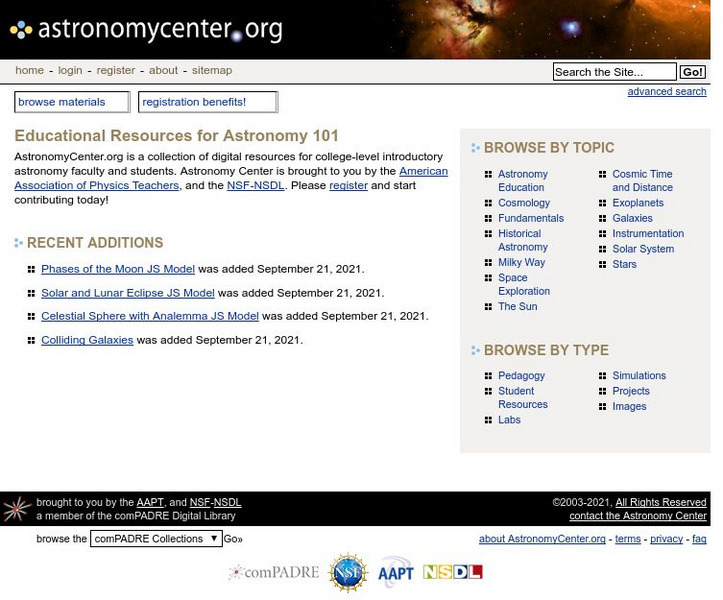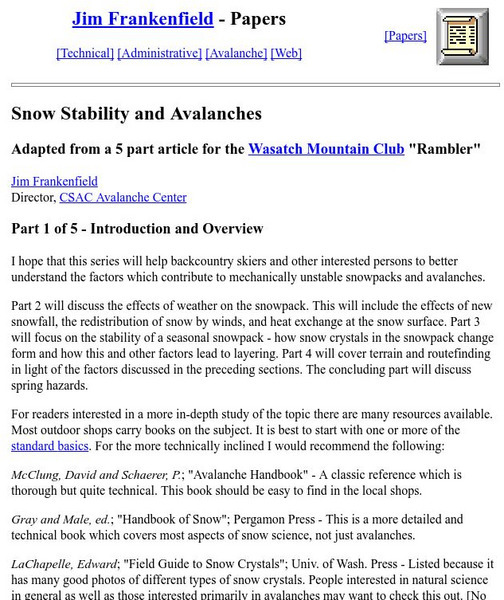Curated OER
Environmental Education
Second graders examine how their choices affect the environment. They identify different types of pollution and its source. They ask questions to end the lesson.
Curated OER
Creating Clinflict Through Gibberish
Students explore ways to communicate and solve conflict. At the beginning of class, students must communicate emotions without using words. They brainstorm important relationships in their lives. Next, groups of students create a...
Curated OER
Research a State in the United States
Middle schoolers research one state of the United States of their choice. Using the internet, they gather as much information about the state as possible along with appropriate images. They present their findings to the class in the...
Curated OER
When is Dinner Served? Predicting the Spring Phytoplankton Bloom in the Gulf of Maine (College Level)
Students are able to explain the ecological importance of phytoplankton. They describe the components that influence a phytoplankton bloom. Students interpret satellite images in order to correlate buoy data.
Curated OER
Interpreting An Archaelogical Site
Learners study the site of an archaeological dig site in order to begin looking at how they can be interpreted. They look at a soil profile and respond to a research question that simulates a real site. The other questions are used to...
Curated OER
Animals and People: Who's Behaving Badly?
Students explore the relationship between human beings and animals. They participate in a variety of activities to examine animal behavior. Students create a class book and stage a mock news broadcast.
Curated OER
Homelessness:Key Terms
Students explore the concept of homelessness. In this social issues lesson, students research homelessness through key terms, in order explore the concept in more depth.
Curated OER
Geographic Effects on Precipitation, Water Vapor and Temperature
Students investigate the factors affecting climate using Live Access Server. In this geography lesson, students graph atmospheric data using Excel spreadsheet. They compare and contrast temperature, precipitation and water vapor of two...
NASA
Nasa: Goddard Space Flight Center: Precipitation Education: The Water Cycle
This learning tool from NASA provides educational tools related to precipitation. The water cycle is featured on this portion of the site.
NOAA
Noaa: Space Weather Prediction Center: A Primer on Space Weather
The Space Environment Center put together an introduction to our sun and space weather that it creates during it's 11 year weather cycle. Learn about different solar anomalies and the effects they have on earth with pipelines, geologic...
PBS
Pbs Learning Media: Earth System: El Nino's Influence on Hurricane Formation
This video segment adapted from NASA's Goddard Space Flight Center explains how and where hurricanes develop. Learn how El Nino events alter the course of atmospheric circulation. Includes background reading material and discussion...
PBS
Pbs Learning Media: Earth System: El Nino
This video segment adapted from NASA's Goddard Space Flight Center details some of El Nino's far-reaching effects on both marine life and humans. [2:44]
NASA
The Solar Data Analysis Center (Sdac)
The Solar Data Analysis Center at NASA provides all the latest information learned about the sun. Content includes a look at information brought back by several satellites.
Michigan State University
Michigan State University: Digital Learning Center for Microbial Ecology: Microbe Zoo
Explore the "many worlds of hidden microbes" in different areas of the Microbe Zoo: DirtLand, Animal Pavilion, Snack Bar, Space Adventure, and WaterWorld. A fun and informative resource that sheds light on the role of microbes in our...
NASA
Nasa: Rockets Educator Guide: What Comes Next
Learn about NASA's plans for the next 50 years to replace the space shuttle. Discover how the new plan involves two new launch vehicles.
University of Utah
University of Utah: Learn Genetics: Space Doctor
Enter the Extraterrestrial Gene Therapy Lab to test your knowledge of gene therapy when you treat three ailing aliens who have genetic disorders.
Harvard University
Harvard Univ.: Chandra X Ray Observatory Center
The Chandra Observatory uses x-ray telescopes to learn more about the make-up of the universe. To learn more about x-ray telescopes and to see what they reveal, click here for the official Chandra X-ray Observatory website.
Oswego City School District
Regents Exam Prep Center: Sample Space
Learn and practice the concept of sample spaces. Features include a teacher resource page.
Alabama Learning Exchange
Alex: Robots in Space
During this lesson students learn the history of robotics in space exploration. They use their creativity to develop a robot. They learn about different career opportunities by communicating with robot specialists at the Johnson Space...
TeachEngineering
Teach Engineering: Rocket Me Into Space
One of the exciting challenges for engineers is the idea of exploration. This lesson looks more closely at Spaceman Rohan, Spacewoman Tess, their daughter Maya, and their challenges with getting to space, setting up satellites, and...
American Association of Physics Teachers
Com Padre Digital Library: The Astronomy Center
A searchable collection of "curriculum materials, images, classroom demonstration, learning resources, evaluation instrumnets, and articles about approaches to astronomy education". Users can contribute materials by creating a free account.
Other
U.s. Space and Rocket Center: Space Camp
Join the fun at the Alabama space camp everyone is talking about. Watch behind-the-scenes clips, learn about the program offerings, and register for a week of space adventures. Link to the different levels of camps including Space Camp...
NASA
Nasa Space Place: All About Mercury
Students have an opportunity to learn more about Mercury. Each badge contains a student centered experience to understand another aspect of the planet.
Other
Cyber Space Avalanche Center: Snow and Stability
Learn how the weather effects avalanches. Learn why the spring and and fall are hazardous times. How does the wind effect avalanches?




















